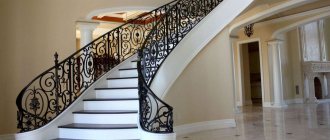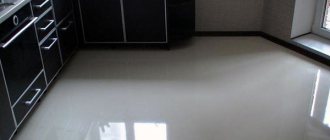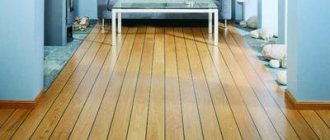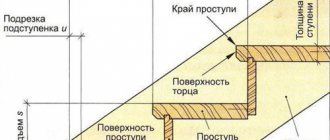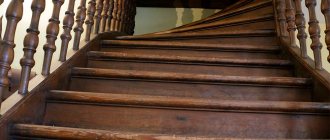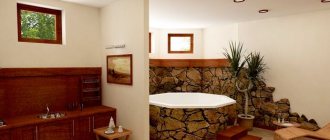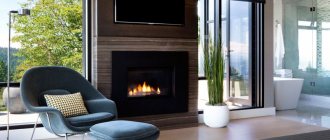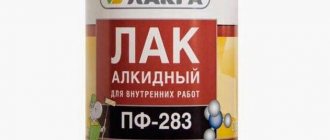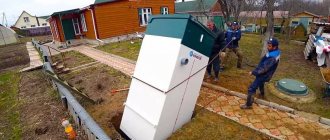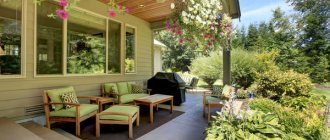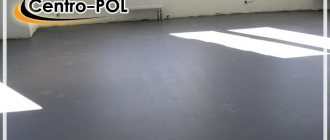A staircase in a house is always beautiful and original. However, such a decision requires a serious approach to finishing. When choosing the best materials for covering steps, you first need to take into account what the staircase is built from, what kind of interior prevails in the house, and what performance characteristics you require from the covering.
At the moment, manufacturers of finishing materials can offer consumers a lot of options. We will consider the most popular and reliable of them. So, how to cover the stairs in the house?
Wooden covering
Natural wood always outperforms other finishing materials. And all because it has a lot of positive properties. Wear resistance, ease of maintenance, versatility - all these are direct synonyms for wooden cladding. There are a lot of options for what kind of wood to decorate the steps with; the more expensive ones are beech, oak, teak, and wenge. From the budget line, it is worth taking a closer look at pine and spruce. After special impregnation, they are practically in no way inferior to expensive types of wood.
Why rubber coating?
You can make porcelain stoneware steps non-slip in various ways. Serifs are applied to them, which increase the surface roughness. As a result, the shoes stop slipping, and you can easily go down in any weather. However, in this case, the appearance deteriorates, since there is a feeling that the steps have been accidentally damaged during operation.
Rough surface
Rubber covering for porches has a number of advantages that force consumers to choose it:
- Anti-slip effect. This coating fully meets the requirements for anti-slip coatings. The non-uniform rough surface makes accidental slipping impossible, as it reliably adheres to the sole made of any material;
- Shockproof properties. The tile material is elastic. This allows you to absorb the shock in case of an accidental fall. Rubber tiles are laid both on the main surface and on the corners. As a result, the risk of injury is significantly reduced, which is important for children's institutions and organizations visited by older people;
- Shock-absorbing effect, which is ensured by the high porosity and elasticity of the material. As a result, ascent and descent are greatly facilitated;
- Moisture resistance. The porosity of the material leads to the fact that moisture, once on the surface, is absorbed by the pores. This prevents ice from forming. In addition, the moisture then evaporates, which prevents the risk of destruction of the coating itself;
- Resistance to mechanical damage. Rubber coating is an ideal option for a porch, since it, laid outside, takes on the main operational load. Even if the janitor decides to use a crowbar to remove ice, there is no need to be afraid, the integrity of the coating will not be compromised. If steps made of granite or ceramics are cleaned in this way, characteristic mechanical damage will appear on their surface;
- Operation in a wide temperature range. Temperature fluctuations do not affect the characteristics of the material. Porch tiles work equally well both at -40 degrees below zero and at +80. Therefore, it is laid both outside the building and inside production premises.
Rubber coating can be laid on any base. Installation can be done on your own, you just need to properly prepare the surface before installation.
Ceramic steps are no longer slippery
Image on the cover
It is worth noting that rubber coating cannot be classified as a budget material. Complex production technology affects the selling price of tiles. However, the variety of colors and textures contributes to the fact that this type of coating is in steady demand among consumers.
Color and texture may vary
Wood imitation
Often, for home stairs, homeowners choose more common and budget-friendly coating options based on natural wood. Laminate, plywood and MDF have high wear resistance, and at the same time perfectly imitate the structure of natural wood.
Abrasive tracks
Such anti-slip pads are made in the form of strips, tapes, tracks and adhesive-based mats. Rubber glue and abrasive particles are applied to the base polymer layer, which is why the coating acquires the desired properties. The abrasive is crumbs of various solid substances that have high strength, for example, granite.
Advice! To treat steps, it is most convenient to purchase a coating in the form of narrow self-adhesive strips. It is very easy to install, and its service life will be at least 3 years without the need for dismantling during the warm season.
Anti-slip abrasive tape Regart fr-Luxe
The cost of abrasive coatings is low, and they can only be used where the loads will not be too severe. With high traffic, the tapes will quickly peel off from the surface.
Clinker tiles
If we talk about tiled staircases, the construction market offers no less options than with wood. A striking example of this is clinker tiles. This coating is very popular for finishing internal stairs, as it has unsurpassed wear resistance, durability and anti-slip properties. In addition, manufacturers offered a wide range of clinker tiles, rich in their variety of textures and shades. Therefore, there should be no problems with selecting finishing materials to suit every taste.
Porcelain stoneware coating
Porcelain tile is not a cheap material. However, its price is fully justified by its high quality. You don’t have to worry about the durability of steps with such a coating for many years. Caring for it is quite simple and does not require special skills. In addition, a good advantage of porcelain stoneware is its variability: plain, contrasting, matte, glossy, imitation wood and natural stone, etc.
However, when deciding to cover the steps with porcelain stoneware, home owners need to remember that the glossy version of this finish is very dangerous for human health, it is slippery and unstable. Therefore, if you really want to have shiny, glossy steps in your house, take care of the safety of the residents and use anti-slip pads.
Choice of paint and varnish
How to paint a pine staircase? Or, if your choice is a varnish coating, what should you use to varnish it with?
It is worth separating the working surface of the steps and all other elements of the staircase: they have completely different modes of operation. The steps are subject to severe wear and tear; In addition, pine, as we remember, is a species with low wood density. Stilettos or hard heels may well leave marks on it if the strength of the protective layer is low.
On the other hand, handrails and accessories for stairs (bowstrings, balusters) and the back side of the steps are practically not exposed to loads. Any coating will serve mainly decorative functions - of course, in addition to protection from rotting and moisture.
Hence the choice of materials:
- For the working surface of the steps, alkyd-based floor enamels are used - domestic PF-266 and imported analogues. Brand preferences are deeply subjective, so we will not name specific names in order to avoid accusations of hidden advertising.
- The best varnish for pine stairs (more precisely, for the surface of the steps) is polyurethane parquet. Its price is quite high; but it forms an extremely durable and wear-resistant surface.
Advice: it is better to choose matte or semi-matte varnish rather than glossy. It shows less visible signs of wear, which will inevitably appear in the center of the steps, even after a long time.
Accessories for stairs: types and purpose
For surfaces that are not subject to intense mechanical stress, we can again recommend alkyd enamels PF-115 for exterior use. They are weather resistant but are not intended for painting floors. With varnishes it’s even easier: our requirements are fully satisfied with inexpensive nitrocellulose varnishes of the NTs series or alkyd PF-170.
Ceramic tile
Rounding out the list of coverings for home stairs is a very budget option - ceramic tiles. Despite its low cost, this finish has a no less attractive appearance than the options listed above.
In addition, the characteristics of ceramic tiles are ideal for cladding steps: many models have anti-slip properties, resistance to mechanical damage and wet environments, ease of care and a wide range of colors, textures and designs. If you do not have exorbitant amounts of money to decorate the internal staircase, then covering with ceramic tiles will be the ideal solution.
Today there are a lot of options for covering stairs, so the only difficulty for you will be to choose one.
PAINTING THE STEPS
The easiest way to give a concrete staircase a decent appearance is to cover it with opaque paint. This finish requires a smooth and even base. If the concrete surface is rough, it should be sanded or a suitable flowable leveling compound applied to it. The best and easiest way is to cover the steps with inexpensive water-based acrylic paint (for concrete). Applied in two coats, it will last for many years. The drying time for this paint is several hours.
Why do you need finishing stairs and steps?
The purposes of coating work may be different, and, accordingly, finishing methods and materials will also vary.
So, the tasks of staircase cladding:
- If the stairs are wooden, then you need to protect the steps from temperature changes and changes in humidity in the room;
- Protection of steps from mold, insects, etc.;
- Finishing the steps, based on the design of the house;
- Anti-slip features;
- Masking surface irregularities and other damage;
- Noise absorption.
Carpet on open stairs
On open staircases, the carpet is usually laid from the wall to the railing posts, and on closed staircases - from one wall to the other.
If you want to lay the carpet in such a way that it can be easily removed and laid on some other staircase, then you can lay a carpet runner that will cover the central part of the steps. The side surfaces of the steps can be varnished or painted.
If you roll up an extra half meter of carpet on the top step, then after about a year the carpet can be removed and moved a little. This will allow the carpet to wear more evenly.
How and how to decorate a staircase in a house with your own hands
The most common type of stairs in a private house is a solid wood staircase. But wood is often exposed to various negative factors: dirt, insects, mold, rot.
Therefore, the most common type of finishing of steps is coating with protective varnishes and paints. Paint, in addition to its protective properties, allows you to fit the staircase into the color scheme of the room and correlate it with the wallpaper with which the walls are decorated.
Varnish can give a beautiful look to the steps and highlight the structure of the wood itself.
It is better to use high-strength varnish options:
- Alkyd varnish: forms a durable coating, can be used for external stairs;
- The polyurethane coating forms a special polyurethane varnish: the coating is as strong and durable as possible;
- Multi-component varnish: formed by mixing several components.
The surface after finishing becomes very durable.
How to paint a metal staircase
In a private home there will definitely be a metal staircase, the durability of which largely depends on the protective coating. Therefore, you need to know how and with what to paint the stairs.
In this case, the preparatory work is reduced to removing rust. To do this, you can use an angle grinder with a stiff wire brush, sandpaper or special solvents.
After the rust is removed, the metal surface is degreased and covered with a primer. Painting the stairs can only be done after the primer has completely dried. It is recommended to treat areas where there was rust especially carefully.
If you are working on a ladder that has welded seams, be sure to clean them to a shine.
The coating of a metal staircase must be highly resistant to abrasion and environmental influences. Selecting the desired enamel or paint ,
Proceed directly to applying paint. If the stairs have been previously painted, apply the coating to a small area. If after drying the paint lies well and the old layer does not show through, you can continue working. If the quality does not satisfy you, the old paint will have to be removed.
The painting of steps must be carried out especially carefully; usually twice as many layers are applied to them as to other elements.
Decorative finishing with laminate stairs and wooden steps
You can update the steps or create a staircase project that matches the intended design using laminate flooring.
Laminate can be used to cover concrete, metal or old wooden stairs.
Manufacturers offer a huge selection of laminates of various colors, textures, and strength.
Material for covering steps with laminate boards:
- High-strength (from class 32) laminate, corresponding to the width of the steps;
- Metal or wooden profile;
- Special glue;
- Jigsaw or hacksaw;
- Screws.
Covering steps with laminate begins with preparing the surface. Floor substrates are laid under each step: polypropylene film or cork. This will make it possible to make a reliable coating with sound insulation properties. If the structure has different widths of steps or a complex configuration, then you need to prepare cardboard templates in advance and cut out the base and laminate using them.
The necessary material for covering steps with laminate is edge moldings - curly overlays for decorating corners and joints. They are used to close the joint between laminate boards laid on the step and riser. In addition, edge molding strengthens the attachment of the laminate to the steps.
To ensure a safe descent, staircases made of wood, plastic, metal, aluminum and cork are used. The thresholds are attached with self-tapping screws or glue. And also, the thresholds extend the service life of the stairs, as they protect the edges from wear.
Moldings are available in a variety of colors, allowing them to be perfectly combined with laminate flooring.
Material selection rules
In the huge variety of paint and varnish products that manufacturers offer today, there are several materials suitable for painting wooden stairs. These are various varnishes, stains, impregnations and paints that are easy to apply with your own hands using a roller, brush or spray.
Lucky
Varnishes are most often used for processing wooden structures because they do not cover the grain of the wood, which is very important when decorating the interior of rooms. To decide which varnish is best for treating a wooden staircase, let’s look at their main types.
Oil products are a mixture of resins (artificial or natural) with vegetable oils. Not the best option because it has low wear resistance, but it is cheap.
Alcohol varnishes are a solution of resins with alcohol. During the application process, the alcohol quickly evaporates, leaving a fairly durable layer of resin on the treated surface. The varnished surface is easy to polish, but has low water resistance. Such compositions can be used for painting balusters.
The production of alkyd varnishes is based on alkyd resins dissolved in white spirit or other organic solvent. They have high wear resistance, increased strength, and are not afraid of changes in temperature and humidity. So they can be safely used when processing street stairs.
Epoxy varnishes are characterized by high mechanical strength, water-repellent properties, and inertness to alkalis. Often two-component formulations are sold that require mixing before application.
Experts believe that polyurethane and polyurethane-acrylate varnishes are best suited for treating wooden stairs. They have all the advantages of the above compounds, but have one drawback - a high price, which is compensated by a long service life.
You can also use yacht varnish to paint outdoor wooden stairs. It is produced on the basis of the same polyurethane or other polymeric substances and includes special additives that provide high strength.
Paints
First of all, it is necessary to note that paints hide the grain of the wood, so they are used only if the task is not to emphasize the texture of the wood. Although there are also glazing compounds that can be used to give only a slight tint to a wooden product.
In terms of variety of colors, they have no equal. But not all brands on the market can be used for painting stairs made of pine, oak or other wood.
Here are those recommended for painting wood:
- acrylic. The resulting coating is durable, waterproof and breathable; walking on it is not slippery. Acrylic compositions are suitable for painting stairs to the second floor inside the house; they can be used to process railings, steps and balusters;
- alkyd. Withstands negative temperatures and forms a flat, smooth surface when painted. They must be applied to well-dried wood;
- oil These paints were once the most common, but have now been replaced by acrylic compositions. They take a long time to dry and form streaks; if not handled carefully, they emit a specific smell when painting;
- enamels. Essentially, it is a mixture of varnish and pigment, so the composition has the characteristics of the varnish that was used in its production.
If the wooden staircase is located indoors, then interior acrylic composition is quite suitable for painting it. For outdoor wooden stairs, it is better to choose more durable finishing materials, such as polyurethane.
Impregnations and stains
Antiseptics and fire retardants are used as impregnations for treating wooden stairs.
The former fight the formation of colonies of harmful microorganisms on the wood surface, the latter are fire-fighting agents. Today, manufacturers offer universal impregnations that have these two properties.
Stain is an antiseptic impregnation that changes the shade of wood. It has no other functions. Usually, after applying the impregnations, the stairs are varnished.
Oils
Wood oils are made from a variety of natural oils and are a modern alternative to varnishes. The oil penetrates deeply into the structure of the wood, protecting it from mechanical stress, the appearance of fungi and mold.
Original carpet covering of stairs
Carpet is a fairly popular and beautiful covering for staircase steps. For indoor use only. You should be very careful when choosing the carpet itself, since the staircase is one of the most trafficked places in the house.
Important: do not choose high-pile carpets, because... It is difficult to care for, it will quickly lose its beautiful appearance.
Therefore, you need to choose carpet with increased wear resistance.
The main advantages of carpeting stairs:
- Protects steps from wear: using high-quality carpet, the coating will last a very long time.
- Safety: forms a non-slip coating.
- Provides sound insulation.
- Low labor costs: it’s easy to decorate even stairs with a complex design with carpet with your own hands. This does not require special knowledge or tools.
You can not cover the entire steps with carpet, but only part of the step. To do this, you need to cut out a template from cardboard and attach the carpet with glue.
Finishing
A staircase in a private house is an important element of the interior, the appearance of which must be approached carefully. Specific materials and cladding methods are suitable for structures made of metal, wood and concrete. Knowing the right technology, you can do the finishing work yourself.
Wooden stairs
It is easier to finish a staircase made of wood by painting or coating it with decorative and protective compounds. When choosing a coloring product, it is worth considering the type of wood, its operational and external characteristics. So, cheap types of wood, for example, pine, are best covered with stain or tinted varnish.
When choosing a varnish for treating steps, you need to focus on its composition:
- Alkyd. By covering the steps of the stairs with this composition, you won’t have to worry about their appearance for a long time. The varnish is resistant to moisture and can withstand temperature changes, and the coating is durable and does not wear out for a long time.
- Acrylic. Creates a dense coating that does not fade in the sun and does not turn yellow over time. The surface acquires a gloss that can be compared to a wet effect.
- Polyurethane. This is a reliable and durable coating. The varnish can be used both outside and indoors with high humidity. The best option if you need to paint the stairs in the bathhouse.
To finish a wooden staircase, it is better to first apply stain, and then apply a layer of varnish on top of it. Often, only the steps are painted, and elements such as handrails and balusters can only be covered with colorless varnish.
Depending on the type of composition and its consistency, the appropriate tools are selected. Thus, thick and viscous solutions (varnish or enamel) should be applied using a wide brush with stiff bristles, and liquid solutions should be applied using a paint sprayer.
Metal stairs
To refine metal stairs, the cladding method is used. The frame is usually lined with wood; you can choose any type based on your financial capabilities. However, we recommend choosing medium-density lumber.
Finishing the steps of a metal staircase can be either partial or complete. In the first case, only wooden treads are installed, in the second, the frame is sheathed completely.
The entire process of refining a staircase on a metal frame can be divided into several stages:
1. Determine the future design of the staircase and the method of finishing it - partial or full cladding.
2. Select the type of wood, then prepare the necessary parts from it. For partial finishing, only treads are made; for complete finishing, risers, stringers and railings are also needed.
3. The prepared steps are fixed to the metal frame using self-tapping screws. It is recommended to deepen the caps into the wood by 5 mm; these places can be covered with wooden caps.
4. Next, the stringer is installed - the part that will hide the side of the metal frame. The length and width of the stringer is determined by the dimensions of the flight of stairs.
5. The balusters are installed on the already installed steps. To do this, holes are made in the steps, which are filled with glue, and wooden dowels are inserted into them. Balusters are mounted on the resulting pins.
6. The last stage involves installing the handrail and final finishing - painting with stain or varnish.
Concrete stairs
Finishing of concrete stairs is possible using stone, wood, MDF panels, laminate and tiles. The easiest way is to sheathe the structure with wood. But it is worth noting that the concrete base must be perfectly level, otherwise the differences will have to be eliminated.
The complete finishing process includes the following steps:
1. Preparing the base. The surface of a monolithic structure must be leveled. For minor distortions (no more than one centimeter), it will be enough to apply a leveling cement mixture.
2. Installation of plywood. The so-called underlay is made; for this purpose, sheets of plywood 10 mm thick are taken and fragments are cut out in accordance with the size of the treads. Installation is carried out using the adhesive method - on mastic.
3. Installation of steps. The finished wooden elements are coated with glue on the back side and laid on top of the plywood backing. Additionally, the treads are secured with screws. The risers are installed, they are fastened to the treads with self-tapping screws, screwed “into the counter”.
Finishing a staircase with your own hands is quite simple if you choose the right technology and follow the instructions exactly without skipping a single step. Based on the content in this article, any staircase structure can be veneered. But just remember that the quality of the result directly depends on the correctly selected materials.
Examples of wood lining stairs (3 videos)
Stairs with beautiful and original finishes (65 photos)
Finishing carpets for stairs in the house: choice
You can decorate the steps of the stairs with carpet runners. Recommended for use on straight single-flight stairs.
Important: if the base of the stairs is concrete, use special adhesive for carpeting.
The variety of carpets allows you to decorate the staircase in any style: from classic to modern.
Paths are laid using:
- Nails;
- Special clamp strips;
- Metal fasteners;
- Glue.
In specialized stores you can purchase special carpet overlays for steps.
How to warn and prevent
We were unable to find in the regulatory framework of the Russian Federation a standard for the permissible coefficient of friction and slip for floor coverings in public places. However, the Civil Code of the Russian Federation places responsibility for injuries resulting from a fall on the owners and operating organizations in whose adjacent territory (any public or private building: store, cafe, hairdresser, cinema, etc.) the injuries were sustained. If a citizen receives an injury or other damage to health, expenses for treatment and the purchase of medicines are also subject to compensation. Moral damages are also subject to recovery in favor of the victim (Articles 1064, 1085 of the Civil Code of the Russian Federation).
What preventive measures should be taken:
- Install “Caution for slippery steps” warning signs/placards.
- Equip the stairs with handrails.
- Provide sufficient lighting for the stairs.
- Visually separate each step from the previous one. Those. so that the pedestrian does not miss the step without noticing its edge.
- Keep the stairs clean and remove snow and ice on time.
Step cladding
As mentioned earlier, we were unable to find Russian Federation standards regarding slip resistance coefficients applicable when arranging stairs. However, in some countries such regulations exist. Manufacturers often use German standards DIN 51097 and DIN 51130 or European standards CEN / TS 16165. Floor finishing materials are also marked accordingly. Slip resistance is measured using a tribometer (there are several varieties, from mechanical to electronic), or a ramp with an adjustable angle of inclination (method developed in Germany).
The DIN 51130 standard provides 5 categories of “slipperiness” depending on the angle of inclination of the surface. The degree of slip resistance is provided by the surface relief of the finishing material and is indicated by the letter R with numbers from 9 to 13 . These numbers indicate the ability of the surface to prevent slipping. The better the effect, the higher the number.
Most manufacturers of ceramic tiles, porcelain tiles, clinker tiles, which are most often used for cladding steps, mark their products with the indicated designations, from R9 to R13.
- For cladding entrance steps, various sources recommend using materials marked from R9 to R13. The best option would be a product marked R13 .
Application of abrasive coatings
Polyurethane paint “PK-2” Anti-slip
Today, there are anti-slip paints and varnishes on sale that contain abrasives (often quartz filler). Such materials are used for finishing stairs made of metal, concrete (for example, TECMA PAV - 13 ), wood, and fiberglass. These coatings are produced in various colors, textures, and with different fractions of abrasive material. It is worth noting here that the larger the fraction, the more suitable it is for winter operating conditions.
Abrasive metal coating made by plasma spraying
On metal stairs, the abrasive coating can be applied by any of the methods (stamping, cutting, plasma or laser cutting, welding, etc.). In the Western market, there are companies offering plasma spraying services for abrasive coatings on metal surfaces, such spraying has a surface hardness of up to 62 on the Rockwell scale, and the bond strength exceeds 4500 pounds per square inch. However, it was not possible to find a company offering this kind of service on the territory of the Russian Federation (at the time of writing this article).
Flaws
- Low efficiency in icing and snow conditions.
- Rapid abrasion of some types of abrasive coatings, in particular paints and varnishes.
- When painting all the steps in the same color, a person may make a mistake with the step size and miss the step. Coloring should be done in such a way that each subsequent step is visually separated from the previous one.
Anti-icing and snow-melting systems
An anti-icing system is an engineering solution that increases the operating comfort of a facility, and most importantly, its level of safety. For its effective operation, sufficient water drainage must be ensured, which must be implemented at the design stage. Known solutions are presented below.
- Heating cable. Most commonly used system ;
- «Water heating. Less popular, but used quite often ;
- Outdoor heating using thermomats or infrared lamps. A relatively new solution.
What kind of anti-slip coatings for stairs are there?
Non-slip coverings for steps are used on both indoor and outdoor stairs. Safety is a very important aspect when choosing stair covering materials.
In our climatic conditions, street stairs must be equipped with anti-slip elements. But internal stairs also require anti-slip elements if the steps are covered, for example, with linoleum or tiles.
Anti-slip coatings for stairs are made from thermoplastic elastomers, abrasive materials, rubber and aluminum, using cork and rubber or rubber coating.
Overlays for stairs C3
They are monolithic L-shaped elements, the sides of which are made at an acute angle relative to each other. Manufactured from thin-walled concrete using patented technology. The unity of the tread and riser ensures the strength of the structure and the speed of cladding.
The overlays are molded to the individual dimensions of the customer's staircase, so high precision is achieved and the ability to do without complex preparation of the base is achieved. In some cases, in order to achieve an optimal “fit” of the overlays for the rough steps, installers cut them locally.
The elements have different variations of facial texture. In any case, the linings are characterized by a relief, which leads to anti-slip properties of the steps.
Previous article
Next article
Choosing finishing materials for the external cladding of stairs
The finishing of the steps is completed. Now you need to take care of the finishing as a whole (lining the space under the stairs, stringers and fasteners) to give the stairs a finished look.
Usually used:
- Finishing with plywood: it is easy to sheathe a flight of stairs of any design. You can use the space under the stairs to create a pantry, mini-library, etc.
- Plasterboard finishing: used in the same way as plywood. To install the structure, first attach a frame made of a metal profile. GCR takes any shape, in addition, the material is quite light, so this finishing is easy to do with your own hands.
- Textured plaster: used to decorate plasterboard sheathing. First, all joints and fastening points are sealed with ordinary plaster, then the entire surface. After it dries, textured plaster of any color is applied.
- It is recommended to use tiles for stairs located in the kitchen or outdoors. It can be laid over the entire under-stair surface or combined with wallpaper, plaster, mosaic, etc.
This finish is suitable for marching stairs.
Screw and cantilever ones have structures that are separate from the wall; they are beautiful and light in appearance, so they do not require special finishing.
Types of stairs depending on the material used in their manufacture
Stairs used indoors and outdoors can be made from different materials, often from combinations of them. Let's look at what staircase structures are made of.
Made from concrete
Stairs made of concrete are actively used in the construction of entrance groups, for organizing access to different floors, or simply for connecting levels on the territory. They are strong, reliable, wear-resistant, resistant to fire and temperature changes.
However, such structures also have some disadvantages. When deciding how to cover a concrete staircase in a house or on the street, you should remember that concrete is destroyed by contact with water, so any coating must protect it from this impact.
In addition, the finishing material should decorate a rather nondescript structure made of raw concrete.
Concrete structure with wooden steps
From stone
Stone structure
Stone structures are rarely faced with any coatings, except that some types of stone can be coated with wax or acrylic-based varnish, which protects the material and shows color (this is especially true for slate, since it is quite soft and easily scratched). Sometimes tiles are used for greater decorative purposes.
It is important to ensure safety when using the ladder. To do this, anti-slip notches or strips are applied to the steps, since slipping is quite easy, especially if the stone is polished,
From glass
Glass stairs greatly decorate the interior of the room. These graceful structures give the impression of weightlessness and even the erroneous impression of their fragility. In fact, the glass used for their manufacture is durable and can withstand heavy loads.
Glass construction
Glass structures do not require additional finishing, but the application of anti-slip notches is very welcome.
Made of wood
Wood is a very popular material for staircase structures. It itself is very attractive to look at. However, to increase resistance to adverse environmental influences and, what is also important, protection from damage by pests (bugs), it must be treated with protective compounds.
After which you can carry out further finishing: either simply cover it with paints and varnishes, or decorate it with other coatings, for example, WPC or laminate (read more here).
Wooden staircase
Made of metal
Metal systems are installed indoors, but more often - outdoors: to organize the entrance to the building, climb to the attic (read more here) or to perform household and repair work.
Metal structure
Since they do not look very attractive without finishing, it is recommended to cover them with other coatings that have a more decorative appearance. In addition, the metal itself is quite cold, and moving on it and touching it with your hands, especially in cold weather, does not bring any pleasure.
However, if you are not going to use finishing materials, the metal structure itself should be treated against corrosion, otherwise the staircase will quickly lose its aesthetics and will soon simply become unusable.
Made of brick
Brick stairs installed on the street look unusually solid, even respectable. They are durable, reliable, not too susceptible to external destructive influences and have a long service life.
They do not need to be finished with anything, unless this is necessary for the design of the surrounding area. Then there are the following options: use tiles, for example, clinker, stone, or, which is very rarely practiced, wood.
Brick construction
For any type of coating, it is necessary to protect the structure from the negative influences to which the material is exposed, add decorativeness to it, ensure safety of movement, and the finishing material must fit well into the interior or exterior of the surrounding space. So, the problem of how to cover the stairs can be solved through a long and careful study of possible options and the building materials market.
Do-it-yourself laminate staircase finishing (video)
The modern market allows you to finish staircase steps in accordance with your design, functionality, financial capabilities and necessary needs. It’s easy to make a staircase beautiful and safe with your own hands at low cost.
A staircase is only a structure that requires flooring. And this is a plus, because in this case you can choose. Today there are many options for such coatings, but how do you choose the best one based on the fact that it must be safe, durable and easy to clean?
Do I need to paint stairs and hardwood?
Most experts answer positively to the question about using varnishes for hardwoods. The presence of a varnish coating will only improve the conditions for the use of wood.
If possible, use expensive types of varnish. Products will last longer if you don't save money when creating them.
Attention! If you want several generations to run up the stairs for a hundred years or more, use yacht varnish.
Epoxy varnish, two-component
In order to do the job efficiently, you can invite specialists. Home craftsmen do this kind of work with their own hands.
Wooden cladding of stairs
Wood is an excellent flooring for stairs: it is beautiful, it can be painted, “refreshed” with various means (for example, varnish). This coating is easy to care for. Of course, the harder the wood, the better, because the steps are constantly under load and, as a result, wear out. Today, coverings for stair steps are made from almost all types of wood, but the choice, as always, is up to the consumer.
The best wood for stair steps is considered to be hardwood: oak, beech, elm, walnut, ash, linden, teak, mahogany, etc. This coating will last a long time, and without visual changes. Soft wood: maple, pine, spruce, cedar, fir, larch, birch will also last quite a long time, but will begin to wear out over time. Price may be an issue: hardwood flooring is expensive. If it is not possible to purchase it, you can use soft wood, and after 10-12 years simply replace the coating.
A staircase lined with wood looks harmonious with a similar finish. Wooden wallpaper or wall panels, cork wallpaper, etc. are suitable.
Review of varnishes for wooden stairs
Criterias of choice
The rise from the first to the second floor is not exposed to atmospheric influences, like street stairs. But in any case, the finish will be more durable if its properties meet the operating conditions of the staircase structure. Therefore, when choosing paints and varnishes for covering internal stairs, focus on:
- microclimate in the house (humidity, presence or absence of heating, sunny or shady side);
- location of the march - on interfloor climbs the traffic and loads are higher than on auxiliary ones (in the basement, in the attic);
- composition of paintwork materials, which determines toxicity, drying time of the varnish, and speed of work. One-component compositions do not require dilution; they are immediately applied to the surface. Two-component - mixed before varnishing. Professionals prefer two-component varnishes as they are more durable;
- degree of gloss (glossy, matte, semi-matte, semi-gloss). Gloss visually expands the space, matte emphasizes the beauty of the wood texture;
- wood species It is not advisable to use varnishes for treating coniferous species on hardwood species and vice versa.
heat resistance (for rooms with an increased risk of fire);
There are self-priming mixtures on sale that allow you to do without preliminary preparation of the wooden base for varnishing (puttying cracks, craters).
Classic varnish is transparent. Paintwork materials with pigments give the wooden staircase the necessary shade or completely change its color.
We recommend choosing varnishes that well protect steps and other elements from moisture and wear, highlight the natural beauty of the wood and last for at least 5 years.
Composition of varnishes for wooden stairs, properties
Nitrocellulose (NC). The base is wood or cotton cellulose. Antiseptics are added to NTs-218 to prevent rotting of wood and the appearance of insects in it. Film - without color or colored. Good adhesion to the base. To obtain a durable film, cover with two layers. The varnished surface can be sanded. Drying time for one layer; 60-90 minutes at room temperature. They are used only in warm houses, since at temperatures from +12 to +60̊ the coating quickly collapses. For unheated rooms, NTs-24 is suitable, which is water- and frost-resistant. Disadvantages - increased flammability, sensitivity to moisture, UV radiation. You can put stain under the varnish. Due to its low cost, it is used for finishing economy-class wooden stairs.
Polyurethane - made from resins, polymers, additives. Durable, elastic, moisture-resistant film maintains its integrity for up to 8-10 years. Polymerizes at +23-25 degrees in 4-10 hours. There is no smell. The coating does not deteriorate from household detergents, but liquids containing alcohol leave permanent stains. They cover stairs with increased operational loads, during intensive use of the ascent to the second floor. You can coat surfaces after polyurethane, NC, alkyd varnishes, paints. Special working conditions - temperature +18-25, humidity - 25-60%.
Acrylic. One-component composition - based on acrylic, two-component - acrylic + polyurethane (increased coating strength). The composition contains no organic solvents. Does not emit strong chemical odors. Resistant to all kinds of influences. Has a high degree of fire safety. Polymerization time is 2-3 hours, complete drying is 18-36 hours. Working at temperatures below +18-25, humidity above 50%, increases drying time and efficiency. Disadvantage - can lift wood fibers, high price. For stairs, select paints and varnishes marked on the packaging “for all types of floor coverings.” Apply an acrylic primer under the varnish.
Alkyd. Synthetic resin with solvents and additives forms a film that is resistant to abrasion and mildly aggressive solutions. Dries from an hour to 2 days. It smells. The fumes are felt for almost a month after drying, so it cannot be used in houses with poor ventilation if children's rooms are located on the second floor. Suitable for stairs that need to be washed frequently. An example of a moisture-resistant and weather-resistant alkyd coating; yacht varnish that lasts up to 5 years.
Epoxy. They are moisture resistant. It takes 96 hours to dry completely. By adding a hardener, the drying time is reduced to a day. Cover interfloor stairs that can withstand significant loads. Epoxy resin with the addition of polyurethane protects the march from moisture, dirt adhesion, rotting, and mold. Steps coated with epoxy-polyurethane coatings do not creak (there is no diffusion of materials). Disadvantages - requires updating after 15-18 months; too thick a layer of paintwork will wrinkle.
Which varnish should I choose for steps and other elements subject to high loads? The most abrasion-resistant ones are polyurethane compounds. The glossy finish is slippery and shows dirt and marks well. The strong reflective effect causes discomfort when descending or ascending. We recommend a semi-matte finish - it is not too shiny and stains are not so visible.
Ceramic or porcelain tiles on the stairs
Ceramic tiles are often used as flooring for staircases: they are very practical and durable. As for the choice of tiles, then, of course, you need to choose unglazed ceramic floor tiles (anti-slip). An excellent option is porcelain tiles. The cost of porcelain stoneware covering for stairs will be higher, but it will look very “rich”.
The beauty of the ceramic coating on these stairs is amazing. The secret is to use special Metlakh tiles with a particularly elegant pattern.
Steps and risers made of gray floor tiles with a marble pattern are a practical finish on which dirt is hardly noticeable. Presumably, this cladding will last a long time, since traces of rubbing and scratches on it are almost invisible.
The risers are made of mosaic, the steps are lined with artificial stone tiles. The solution is practical, since this type of stone is very durable.
The noble gray color of the ceramic cladding of the stairs does not attract much attention to the structure. If possible, it is worth taking care of two or three bright spots in the decor.
A combination of dark staircase cladding with room decoration of the same color scheme, but lighter.
Processing agents and traditional methods
There is far more than one way to make the steps completely safe for use, without in any way disturbing the external aesthetic appearance of the stairs. For this purpose use:
Synthetic fluids
Anti-slip liquid
The main principle of operation of these products is the creation of a silicon layer of several microns, providing the necessary roughness. The advantage of using synthetic fluids is their versatility, which allows you to use an anti-slip agent on almost any type of staircase surface. The disadvantages include a somewhat high price.
Coarse sand
An inexpensive and unpretentious shelter option that is suitable even for already frozen steps is ordinary coarse sand. Its main drawback is that it can remain on shoes, so it quickly pollutes the room. On the other hand, sand quickly wears off and is blown away by the wind from the surface, and therefore requires constant updating of the coating.
Towels
An old towel placed on a step will quickly freeze to the ice. Once on the step, the towel instantly turns into a tread strip. This is a great option when your steps are covered in ice and you don't want to waste time trying to melt or chip it off.
Cat litter
Like towels, cat litter and coarse sand provide instant traction in icy conditions. Simply place a layer of cat litter on top of the ice. Kitty litter and sand are natural products that biodegrade, so it's also environmentally friendly.
Magnesium chloride deicer
The best deicer for exterior steps is magnesium chloride. It melts ice down to -10°C, does not corrode metal, does not rot wood or destroy concrete, and is safe for pets and plants.
Salt
Salt is one of the most popular and effective methods of de-icing, but in addition to dissolving the ice, it has an extremely negative effect on shoes, leaving behind white streaks that are difficult to remove and destroying the outer coating, which reduces the service life of the stairs.
Please note that the use of rock salt may cause corrosion of concrete! It is also poisonous to plants that may grow near stairs. In addition, salt is ineffective at low temperatures.
Water and alcohol
Another universal anti-slip agent for covering stairs is a mixture of alcohol, water and any dishwashing detergent. By dissolving 100 grams of alcohol in two liters of water and adding a little degreaser (about ten drops), you will get an effective remedy for combating already formed ice. For practical use, it can be poured into bottles, from which you can then water the stairs if necessary. The advantage of this solution is that the ice will not only become non-slip, but will also completely disappear from the surface, eliminating the need for mechanical cleaning.
Laminate flooring for stairs
Mid-priced staircase flooring is laminate. This material has a fairly wide range of shades and patterns, making it easy to keep clean. True, if your staircase is a busy place, this material will not “last” for a very long time (although, of course, it will serve). In addition, laminate is a material that can slide. And if this is not such a concern on a regular floor, a staircase is a structure that requires special safety. The solution is to install anti-slip strips on the steps. In addition, laminate is suitable for stairs with straight steps due to the shape of the products.
The finishing is discreet and noble. The staircase can rightfully be called a continuation of the floor. Light laminate gives a feeling of lightness, which is important when decorating a staircase.
The broken-shaped concrete staircase structure, lined with laminate, looks luxurious.
Wide laminate panels can be used to create spectacular shaped cladding for steps.
Features of concrete stairs
Today, concrete stairs are considered a durable material. Using modern technology, they can be given any shape. When making it, it is important to remember the following:
- use high quality concrete;
- create a frame from durable reinforcement;
- To remove voids in concrete, use specialized vibration equipment.
Reinforced concrete stairs, installed according to all the rules, have the following advantages:
- high safety margin;
- reliability;
- operational safety;
- moisture resistance;
- resistance to low or high temperatures;
- fire safety (concrete does not burn);
- no need to perform preventive maintenance;
- low cost of operation;
- possibility of any decorative design;
- significant load capacity (heavy loads can be carried);
- long service life.
Among the disadvantages of concrete stairs, we note:
- complex installation, which is accessible only to specialists;
- bulkiness, heavy weight of the structure;
- the need to decorate a nondescript source.
Due to the predominance of advantages over disadvantages, the designs have found wide application in various types of buildings.
Comfortable carpet on staircases
One of the most comfortable floor coverings for stairs is carpet. Firstly, walking on such a surface is safe, secondly, it is always warm under your feet, and thirdly, it absorbs squeaking. Although there are also disadvantages: such flooring for stairs will have to be cleaned more often than hard surfaces, and it will wear out faster. But the same interior for many years is boring. Carpeting can be easily replaced without costing you an exorbitant amount.
If you want to highlight the staircase in the interior, you should think about a carpet with bright patterns. This staircase covering is cozy and warm.
Colored carpet , as a covering option for staircase steps, emphasizes that the atmosphere of the room is homely.
Stripes on the carpet, located along the steps, lengthen the span, set the direction, and add dynamism to the design of the room.
Special fastening strips for carpet on steps are a safety measure. The covering, pressed tightly by the slats, will not slide down your feet - this is important for stairs.
Gray plain carpet is practical, so it is often used as a covering for stairs.
Carpet overlays for steps are decorative and contribute to the comfort of walking on the stairs. The main thing is to fasten them securely. This can be done with glue and special staples. As a last resort, such mats-overlays are fixed to the steps using powerful (construction) double-sided tape.
Coating options
You can learn more about the variety of coatings for stairs by opening the video in this article. You can decorate both individual elements of the staircase (steps, guides, base), and you can line the adjacent surfaces with appropriate material, for example, the wall adjacent to the staircase.
Wall finish identical to staircase cladding
Also, the frame of the staircase structure can be completely covered, for example, with plasterboard, and lined with it in accordance with the general concept of finishing the staircase.
Sheathed staircase frame
Let's consider what materials can be used in finishing stairs to decorate them and improve their performance.
Coloring
The use of paints and varnishes is the most common way to protect structures from the influence of external factors and perform finishing.
Wooden structures
With the help of decorative compositions, you can perfectly decorate wood products, give them the desired shade, and also further increase their resistance to influences.
The standard wood processing procedure consists of several stages:
- Elimination of defects existing on wood using putty and polishing the surface, if this has not been done previously, with a grinding machine.
- Applying a layer of primer . This composition allows you to ensure good adhesion of wood to paint or enamel, obtain an even layer of the finishing coating, reduce its consumption, and also additionally protect the material from factors harmful to it.
Important! The primer composition must be compatible with the paint.
- Coating stairs with paint . There is a wide range of products for these purposes. They differ in the area of application (external or internal treatment), the appearance of the coating, the film-forming substance (drying oils, synthetic compounds, components of inorganic origin), application conditions, and performance characteristics. Choosing, for example, how to cover a pine staircase inside a house, or how to process a larch structure outside, is not so easy due to the variety of materials available.
In order to decide what to cover the steps of the stairs or the entire structure with, you should analyze the conditions in which the structure will be used.
One of the best options for covering stairs in the house is acrylic enamel. It dries quickly, does not smell and creates a durable, moisture-resistant, vapor-permeable, durable protective and decorative layer.
And, for example, alkyd (especially pentaphthalic varnish), nitrocellulose and oil paints are best used for application to external structures, as they have an unpleasant odor.
Types of paint used for wooden structures:
- Varnishes are used for finishing painted structures. They can create a matte or glossy layer (there are also semi-matte options) and provide additional strength and durability to the coating. The varnish should also be selected according to the type of paint used.
Wood varnish
- Stains, wax and oil are also used to finish wooden structures. For example, to decide how to cover a pine staircase so that it looks like mahogany, stains will come to the rescue, allowing you to give the wood the necessary shade. They may have different compositions, but the processing technology for all is identical and simple. After applying several layers of the composition (from 2 to 4), the wood is coated with several layers of varnish.
Various shades of stains
Concrete structures
Painting concrete is not as common as in the case of metal and wood, but this option for finishing stairs also has a right to exist:
- Using this rather primitive method, you can perfectly remove dust from the surface, increase wear resistance and protect concrete from moisture, not to mention the fact that the appearance of the structure will be transformed.
Painted concrete structure
- In order to paint the stairs, the concrete base should be thoroughly sanded and then primer should be applied. The dried surface can be painted with the selected composition. Application is usually done with a brush or roller (with medium bristles). Painting is done in several layers. Acrylic and epoxy paints are suitable for coating concrete.
Epoxy paint for concrete
- For the restoration and decoration of stairs, polyurethane compounds can also be used, for example, “Evropoll PRO PU paint”. This polymer coating for stairs creates excellent waterproofing and has high hiding power. To increase strength and anti-slip characteristics, quartz sand can be added to the composition (pictured).
Staircase coated with “Evropoll PRO PU paint”
Metal stairs
All metal structures, regardless of their purpose and installation location, must be treated with compounds that protect their surface from rust.
In addition to resisting moisture, the paint must form a durable and abrasion-resistant layer. For processing, organosilicon paints, epoxy, perchlorovinyl, oil and alkyd compounds are used.
As a rule, the painting technology consists of preliminary priming of the metal (after removing rust and grinding weld spots) and subsequent application of permanent paint. Additionally, the stairs can be varnished.
Polyurethane paint for metal
Hammer enamels have excellent performance and aesthetic characteristics, which can be applied immediately after loose rust has been removed.
Color options for hammer enamels
Tile
Tile materials wonderfully decorate staircase structures. There are many types of them, they differ in their characteristics, but, as a rule, they are durable, weather-resistant and last a long time.
Ceramic, clinker, porcelain stoneware
All three types of tiles are made from clay, the difference lies in the types of raw materials and manufacturing technologies, hence some differences in properties and a slight difference in appearance. All of the listed varieties are used for interior and exterior decoration of stairs. With their help, you can finish all elements of staircase structures, as well as the surface near them.
The variety of tile models allows you to choose the option to suit your taste. It is available in smooth and corrugated, matte and glossy, plain and imitating textures of various materials.
Finishing the structure with clinker tiles
It is convenient to use these materials to cover the steps of stairs in the house and on the street, since, in addition to the purely tiled version, solid steps and risers are produced, the installation of which is much easier. Moreover, there are also plenty of their models: straight and angular, with and without capinos.
Porcelain stoneware step
You can also select additional elements for cladding stairs: sidewalls, skirting boards, handrails.
Clinker handrail
To install tiles, glue is used, and there are also a lot of varieties: cement-based glue, dispersion glue (suitable for installation on wood, plasterboard or metal), an epoxy composition that has proven excellent frost and moisture resistance.
Tile adhesive
Important! Porcelain tiles and ceramic tiles have a fairly slippery surface, so notches on the steps will help prevent possible injuries.
Of these types of tiles, clinker has the best characteristics in terms of strength and durability, however, its price is higher than that of its analogues.
Rubber
Moisture-, frost- and temperature-resistant tiles are produced from rubber crumbs. It is easy to install and less dangerous. However, this material is a little simple in appearance.
Rubber covering on steps in rolls
In addition to materials made from crumb rubber, the coating for outdoor steps can also be made from vulcanized rubber.
Outdoor stair treads made of vulcanized rubber
Sidewalk
This tile is not particularly elegant, but it is durable, reliable and has good durability. It is often used as a covering for outdoor stairs.
Covering for outdoor steps made of paving slabs
This finish looks especially harmonious in combination with a similar coating of the adjacent territory. If you have a problem with how to cover a concrete staircase, paving slabs are not the worst option.
